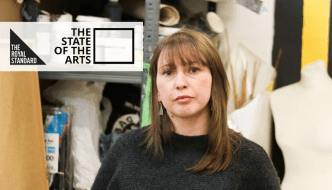An Interview With Spanish scenographer Ana Inés Jabares Pita
February 28, 2015
Ana Inés Jabares Pita is a Spanish scenographer who won the prestigious Linbury Prize for Stage Design in 2013.
Ana Inés first studied fine arts in Seville and then in Accademia di Belle Arti di Palermo, where her passion for scenography started.
Trained as a professional musical artist – she was one of the sopranos in the choir of Galician Symphonic Orchestra in her native Galicia, Spain – Ana Inés has a special sensitivity and creativity that can be appreciated in her artistic works.
After finishing her MA in scenography at The Royal Central School of Speech and Drama, Ana Inés worked very hard to gain a place in the world of arts, creating an outstanding portfolio and presenting it to the Linbury Prize, which crowned her the overall winner of the contest in 2013.
Since then, Ana Inés has been involved in many different creative and theatrical projects in different parts of the United Kingdom, Europe and Canada. She is currently working on a theatrical play with the National Theatre of Scotland.
Ana Inés has a new theatre production which launches Wednesday (25th of February) at Vault Festival in London.

© Alessia Bombaci
TSOTA: Have you always been in touch with the artistic world?
AI: Yes, since I was born. Both my parents are art lovers and have been trained as fine artists, so thanks to them I have been always surrounded by art and I have learnt how to see the world through a different lens.
TSOTA: You studied fine arts, but you have specialized as a scenographer. Why did you choose this particular type of art as your way of living?
AI: I do not consider that I have chosen scenography, the selection process has been really organic. What I mean is that all the decisions I have made in my life, have lead me to discover scenography. In fine arts I always had problems to choose what discipline I wanted to specialize in: sculpture, drawing, painting, installation, video… I also had problems trying to decide if I wanted to be an operatic singer or a fine artist. Finally, I didn’t need to choose, I have just found something that gathers all my passions together and makes me happy.
TSOTA: You’ve lived in three different countries: Spain, Italy and the UK. Could you tell us the differences among these countries regarding their approach to the fine arts?
AI: In all three countries I have lived completely different experiences and learnt something new. In Spain, to be precise, in Sevilla, it is the cradle of Baroque both in music and fine arts (I haven’t had the chance to experience scenic arts a lot). There, you can see that tradition is the engine that makes that city work. Although, it also has amazing contemporary and innovative artists and galleries. In Italy, Palermo, there is a lot of tradition as well. There I had more contact with scenic arts. They have the 3rd biggest Opera house in Europe, the Teatro Massimo. On one hand, there I learnt the tradition of Opera and Ballet, but I also discovered contemporary dance and I started to explore the mixture between music and painting. I also learnt that art is not only about beauty it is also about making people/audiences think about political/social situations – about expressing inner thoughts. Well, in the UK, London, I learnt everything I know about theatre. It’s a city that never sleeps and never allows you to stop doing and experimenting new things; you can find absolutely anything you want.
TSOTA: In London there are several museums with free entrance, including The National Gallery. Do you think culture and art should be free and accessible to everyone?
AI: I definitely think that culture and art should be accessible to everyone but I think we should be careful when we use the word ‘free’. There are ways of funding art and culture that do not require for the audience to pay directly.
For example, when we listen to the radio, or go to a public library, we are not directly paying for the cultural product that we enjoy. But that does not mean that producing culture and art does not cost money: it needs time, expertise, materials, etc. Artists, musicians and theatre-makers in general should be better remunerated for their work.

© Bill Knight
TSOTA: Winning the Linbury Prize is a landmark in your career as an artist. How has it changed your life?
AI: Winning the Linbury Prize has helped me a lot to develop my career faster and meet really interesting people from the industry. Since this happened I haven’t stopped working in something that I really love.
TSOTA: You have a musical background. Would you consider going back to performing as a soprano in the future or would you prefer to continue your career in the fine arts?
AI: All that I have learnt I am trying to incorporate into my work, so who knows?
TSOTA: What kind of projects do you enjoy the most to develop your art – classic stories or more contemporary and modern pieces?
AI: Stories can be classic and you can still make them contemporary. It all depends on the way you transform the things and the people you work with.
TSOTA: What do you look for in a project before you accept it?
AI: The idea behind it. I really need to believe in the project from the beginning, the people I am going to work with and the money.
TSOTA: Governments are not investing enough money in fine arts, but they are investing millions in science projects. What would you tell them to make them change their minds?
AI: I am not sure that the governments are actually investing all the money they should in science projects. In fact, at the moment we are experiencing a difficult period that is also affecting science. I think that science and art are equally necessary: they both help to understand the world though different perspectives. I definitely think that they should be investing more in arts but not at the cost of science, there are a lot of investments in other unnecessary matters.
TSOTA: People are prone to imagining fantasy worlds surrounding actors, theatre and cinema. Tell us if everything is so “perfect” as everyone thinks.
AI: Everything is not as perfect as it might seem. Working in theatre and cinema is not easy, we spend a lot of hours working, sometimes we need to make difficult decisions and a lot of sacrifices but at the end of the day you go to bed thinking that everything is worth it because your dream is becoming true.
Thanks Ana Inés!
Lucía Vázquez Bonome
You can see Ana Inés work here.




Comments